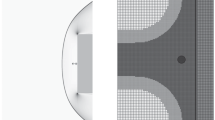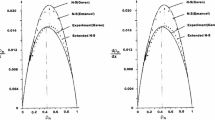Abstract
The paper presents two computational techniques that do not require a change in the topology of the mesh to simulate the flow around oscillating bodies. The first technique uses the immersed boundary method, the second technique uses the method of deformed meshes. The capabilities of these two approaches are demonstrated by solving model problems in a two-dimensional formulation for simulating acoustic fields generated by an oscillating cylinder, both single and in the presence of a fixed cylindrical body, in a subsonic flow.





Similar content being viewed by others
Notes
A detailed comparison of the calculation results by the IBC method and the classical method using a mesh matched to the body is given in [24], where the problem of modeling an unsteady turbulent flow near a three-dimensional cylinder was considered.
REFERENCES
C. S. Peskin, “Flow patterns around heart valves: a numerical method,” J. Comput. Phys. 10, 252–271 (1972).
R. Mittal and G. Iaccarino, “Immersed boundary methods,” Ann. Rev. Fluid Mech. 37, 239–261 (2005).
Ph. Angot, C. H. Bruneau, and P. Fabrie, “A penalization method to take into account obstacles in incompressible viscous flows,” Numer. Math. 81, 497–520 (1991).
E. Feireisl, J. Neustupa, and J. Stebel, “Convergence of a Brinkman-type penalization for compressible fluid flows,” J. Differ. Equat. 250, 596–606 (2011).
O. V. Vasilyev and N. K.-R. Kevlahanv, “Hybrid wavelet collocation-Brinkman penalization method for complex geometry flows,” Int. J. Numer. Meth. Fluids 40, 531–538 (2002).
O. Boiron, G. Chiavassa, and R. Donat, “A high-resolution penalization method for large Mach number flows in the presence of obstacles,” Comput. Fluids 38, 703–714 (2009).
Q. Liu and O. V. Vasilyev, “A Brinkman penalization method for compressible flows in complex geometries,” J. Comput. Phys. 227, 946–966 (2007).
Y. Bae and Y. J. Moon, “On the use of Brinkman penalization method for computation of acoustic scattering from complex boundaries,” Comput. Fluids 55, 48–56 (2012).
I. V. Abalakin, N. S. Zhdanova, and T. K. Kozubskaya, “Immersed boundary method for numerical simulation of inviscid compressible flows,” Comput. Math. Math. Phys. 58, 1411–1419 (2018).
R. Komatsu, W. Iwakami, and Y. Hattori, “Direct numerical simulation of aeroacoustic sound by volume penalization method,” Comput. Fluids 130, 24–36 (2016).
D. J. Mavriplis, “Mesh generation and adaptivity for complex geometries and flows,” in Handbook of Computational Fluid Mechanics, Ed. by R. Peyret (Elsevier, Amsterdam, 1996), pp. 417–459.
P. Renzoni et al., “EROS a common European Euler code for the analysis of the helicopter rotor flowfield,” Prog. Aerospace Sci. 36, 437–485 (2000).
R. Steijl and G. Barakos, “Sliding mesh algorithm for CFD analysis of helicopter rotor-fuselage aerodynamics,” Int. J. Numer. Meth. Fluids 58, 527–549 (2008).
B. E. Pobedria and D. V. Georgievskii, Fundamentals of Continuum Mechanics. Lecture Course (Fizmatlit, Moscow, 2006) [in Russian].
I. V. Abalakin, V. A. Anikin, P. A. Bakhvalov, V. G. Bobkov, and T. K. Kozubskaya, “Numerical investigation of the aerodynamic and acoustical properties of a shrouded rotor,” Fluid Dyn. 51, 419–433 (2016).
I. V. Abalakin, P. A. Bakhvalov, V. G. Bobkov, T. K. Kozubskaya, and V. A. Anikin, “Numerical simulation of aerodynamic and acoustic characteristics of a ducted rotor,” Math. Models Comput. Simul. 8, 309–324 (2016).
I. V. Abalakin, P. A. Bakhvalov, O. A. Doronina, N. S. Zhdanova, and T. K. Kozubskaia, “Simulating aerodynanics of a moving body specified by immersed boundaries on dynamically adaptive unstructured meshes,” Mat. Models Comput. Simul. 11, 35–45 (2019).
P. A. Bakhvalov and V. A. Vershkov, “Edge-based schemes on moving hybrid meshes in the NOISEtte code,” KIAM Preprint No. 127 (Keldysh Inst. Appl. Math., Moscow, 2018).
I. V. Abalakin, P. A. Bakhvalov, A. V. Gorobets, A. P. Duben, and T. K. Kozubskaia, “Parallel research code NOISEtte for large-scale CFD and CAA simulations,” Vychisl. Metody Programm. 13, 110–125 (2012).
V. A. Vershkov, “Algorithm of mesh deformation for accounting cyclic blase control and blades flapping in the problem of helicopter main rotor modeling,” Nauch. Vestn. MGTU GA 22 (2), 62–74 (2019).
P. A. Bakhvalov and T. K. Kozubskaya, “Construction of edge-based 1-exact schemes for solving the Euler equations on hybrid unstructured meshes,” Comput. Math. Math. Phys. 57, 680–697 (2017).
I. Abalakin, P. Bakhvalov, and T. Kozubskaya, “Edge-based reconstruction schemes for unstructured tetrahedral meshes,” Int. J. Numer. Meth. Fluids 81, 331–356 (2002).
L. Qu, C. Norberg, L. Davidson, S. H. Peng, and F. Wang, “Quantitative numerical analysis of flow past a circular cylinder at Reynolds number between 50 and 200,” J. Fluid Struct. 39, 347–370 (2013).
I. V. Abalakin, A. P. Duben, N. S. Zhdanova, and T. K. Kozubskaia, “Simulating an unsteady turbulent flow around a cylinder by the immersed boundary method,” Math. Models Comput. Simul. 11, 74–85 (2019).
Author information
Authors and Affiliations
Corresponding authors
Ethics declarations
This work was supported by Russian Science Foundation, project 16-11-10350.
Rights and permissions
About this article
Cite this article
Abalakin, I.V., Vershkov, V.A., Zhdanova, N.S. et al. Numerical Simulation of Acoustic Fields Induced by a Flow Past an Oscillating Solid. Math Models Comput Simul 12, 422–432 (2020). https://doi.org/10.1134/S2070048220030023
Received:
Revised:
Accepted:
Published:
Issue Date:
DOI: https://doi.org/10.1134/S2070048220030023




